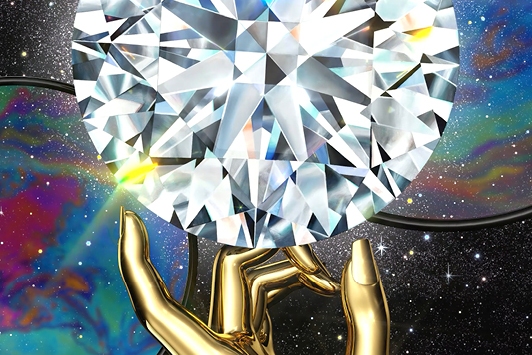 Image: Reena Ahluwalia
Image: Reena AhluwaliaNo longer the preserve of the initiated few, non-fungible tokens (NFTs) made headlines in the international press during 2021 and are set to attract growing interest in the coming years. Sportswear giant Adidas, luxury brands Louis Vuitton and Gucci, and auction houses Christie’s and Sotheby’s are some of the household names that have embraced this often inscrutable new technology.
“Luxury items help define one’s style identity, and with the evolution of the metaverse, we are seeing...brands historically known for creating physical items shift their focus to virtual, in the form of luxury collectible NFTs,” explains Caitlin Donovan, Christie’s head of department for handbags and accessories. “Like many collectible luxury items, NFTs are highly rare items, with the ability to appreciate in value over time.”
NFTs have a broad range of uses in the luxury world, according to diamond artist and jewelry designer Reena Ahluwalia. They can mark collectibles and one-off pieces; selling them can raise funds for important causes; and companies can capitalize on their hype to raise brand awareness with a passionate audience of digital natives, she explains. This past December, in partnership with LuxuryFintech founder Erik A. Jens, Ahluwalia launched the first-ever Diamond Art NFTs — a limited collection of 10 digital artworks — on OpenSea Marketplace.
NFTs felt like a natural evolution for Ahluwalia. “As a designer and artist, I am passionate about what technology can do. My launching NFTs can actually be traced back to all the digital innovations I was trying to bring to the jewelry and diamond world,” she says. “My NFTs are my artistic point of view, an entry into my mindscape, of the connection between jewelry, diamonds and art, that’s been my life’s work.”
A committed audience
Early collectors in this field have included the aforementioned digitally native generation, as well as savvy investors, says Noah Davis, Christie’s head of digital art. He points to “young people from around the world, typically with a passionate connection to technology, as well as some intrepid old world art collectors, forward-thinking institutions, and very many traders.”
A high percentage of the NFT market’s overall volume is based on speculation, Davis adds, noting that a growing number of “super-committed collectors and builders” are entering the space.
From an investment perspective, buying an NFT includes not just the right to resell it, but also to take advantage of other features that might come with the asset.
“NFTs don’t just provide a kind of digital ‘deed.’ Because blockchains are programmable, it’s possible to endow NFTs with features that enable them to expand their purpose over time, or even to provide direct utility to their holders. In other words, NFTs can do things — or let their owners do things — in both digital spaces and the physical world,” says Ahluwalia.
Bought with cryptocurrencies or in dollars, NFTs are part of a blockchain and thus contain a public record of the asset’s transactions, ownership history, and authenticity. This makes them particularly interesting for industries that have put traceability at the top of their agendas.
“We often talk about transparency, the origin of diamonds, characteristics, certification, one-off high-end pieces, unique pieces of jewelry or art — all that can be embedded in the metadata, in the blockchain, and will stay unaltered for perpetuity,” Ahluwalia elaborates. “It’s an undisputed proof.”
The jewelry angle
How the diamond and jewelry industry will employ NFTs remains to be seen. In this sector, it’s the physical object that holds the highest value for most buyers, rather than an associated digital product. And when high-jewelry house Bulgari issued an NFT last year, it was an artwork, which was a more familiar NFT pairing for collectors than jewelry pieces are.
Yet Ahluwalia sees the future as “hybrid, digitized and multi-sensory,” an experience that “will definitely go beyond just the physical objects. I believe we will move into a fully immersive web. Brands need to have a virtual and digital strategy of storytelling.”
The blockchain-based web that NFTs inhabit “currently does not rely on ads for monetization,” she continues. “They don’t rely on Google, Instagram or Facebook to function. It’s community-driven. NFT communities are by far the largest growing digital group, [and they attach] huge value to digital assets along with the products they consume.”
Article from the Rapaport Magazine - February 2022. To subscribe click here.